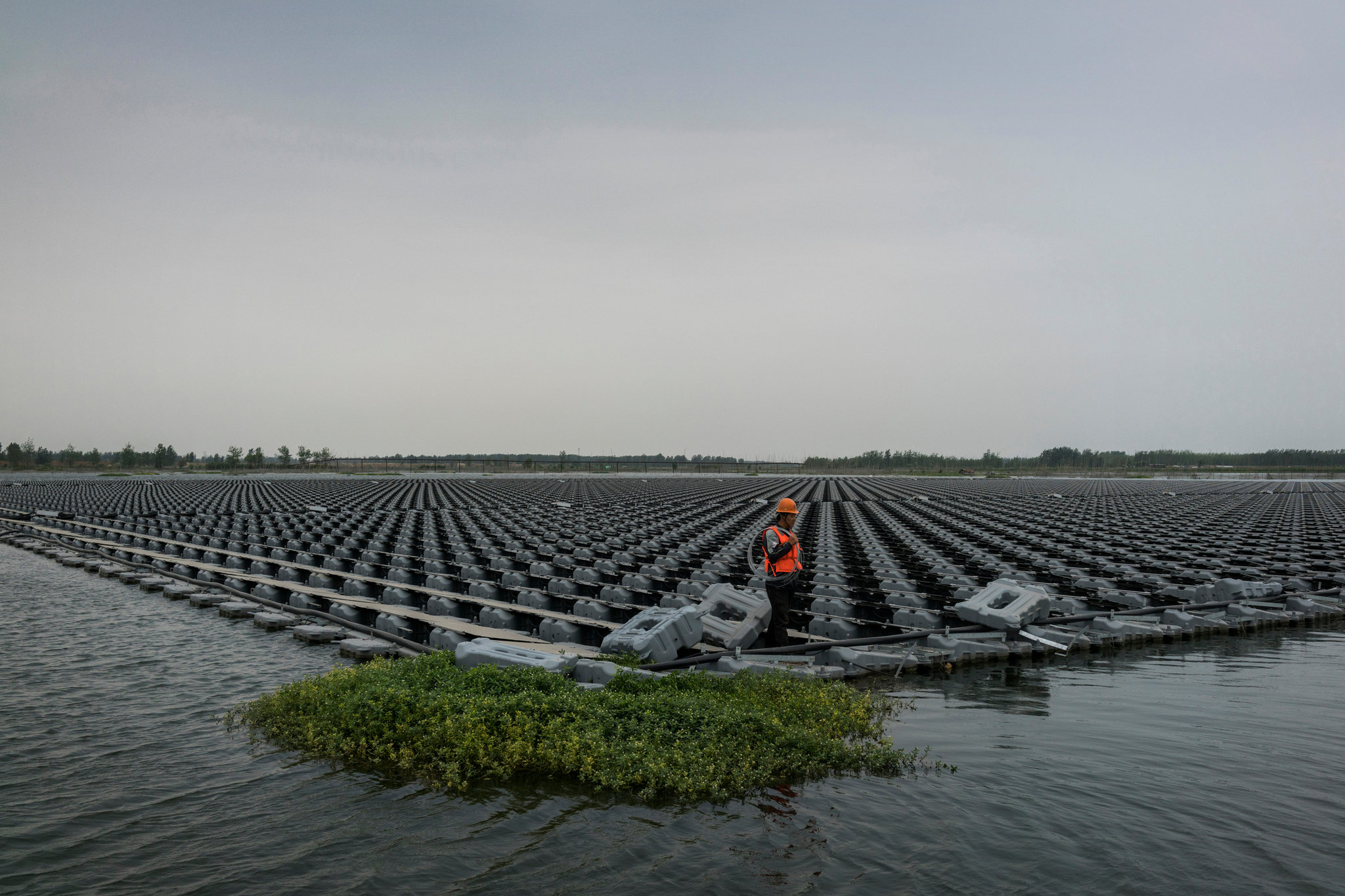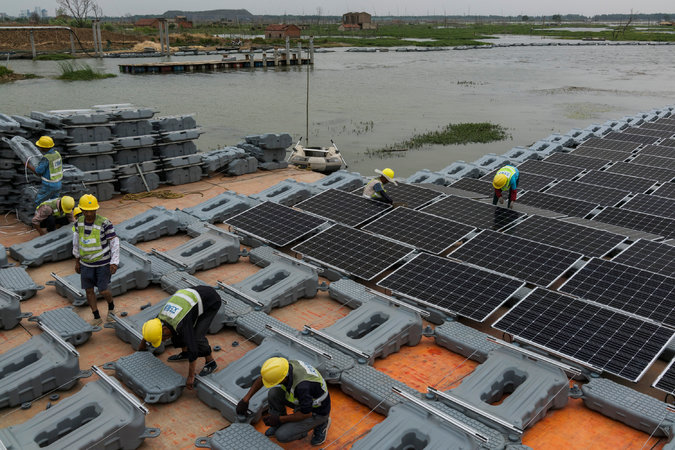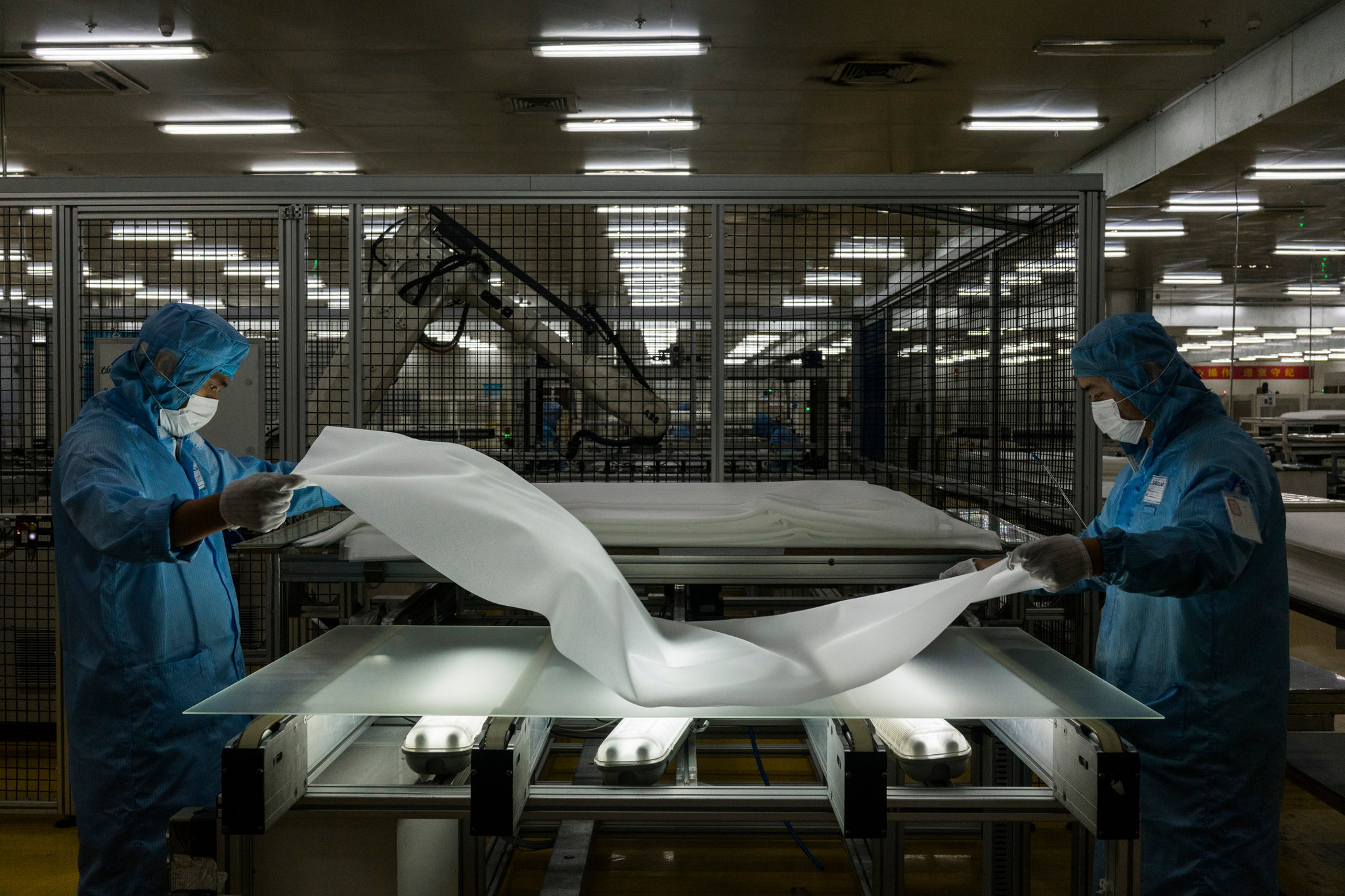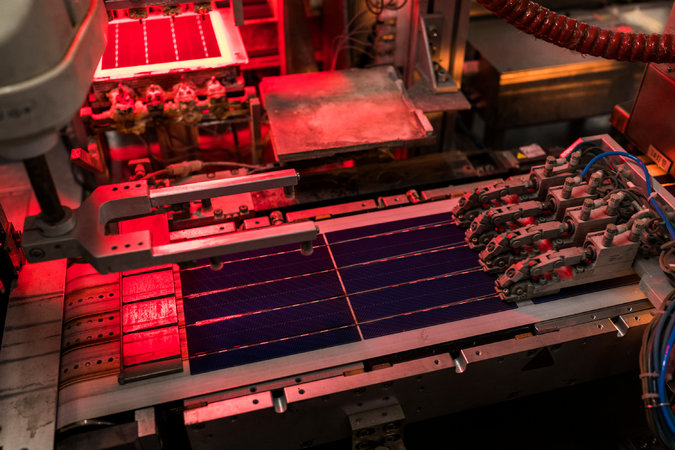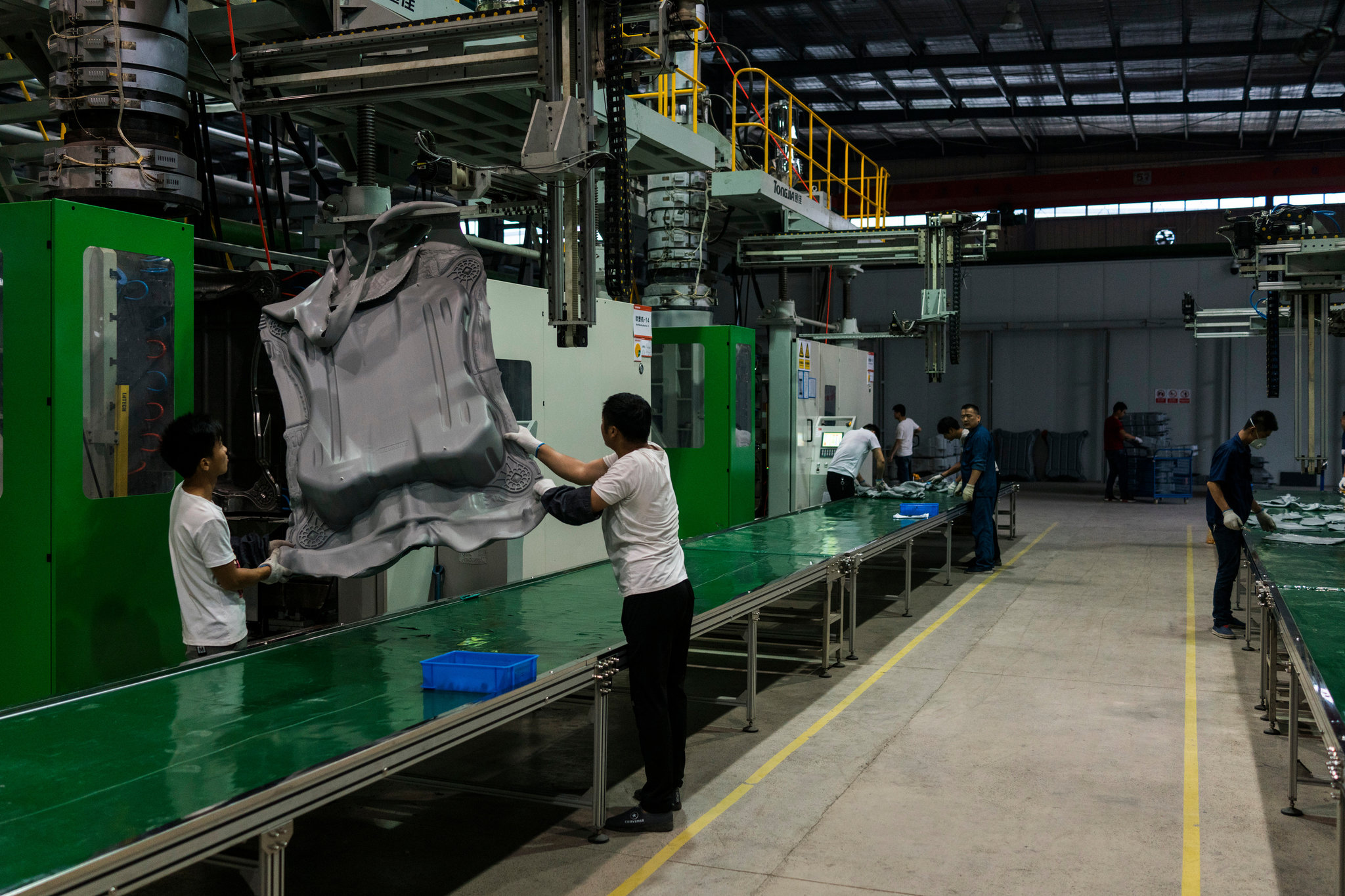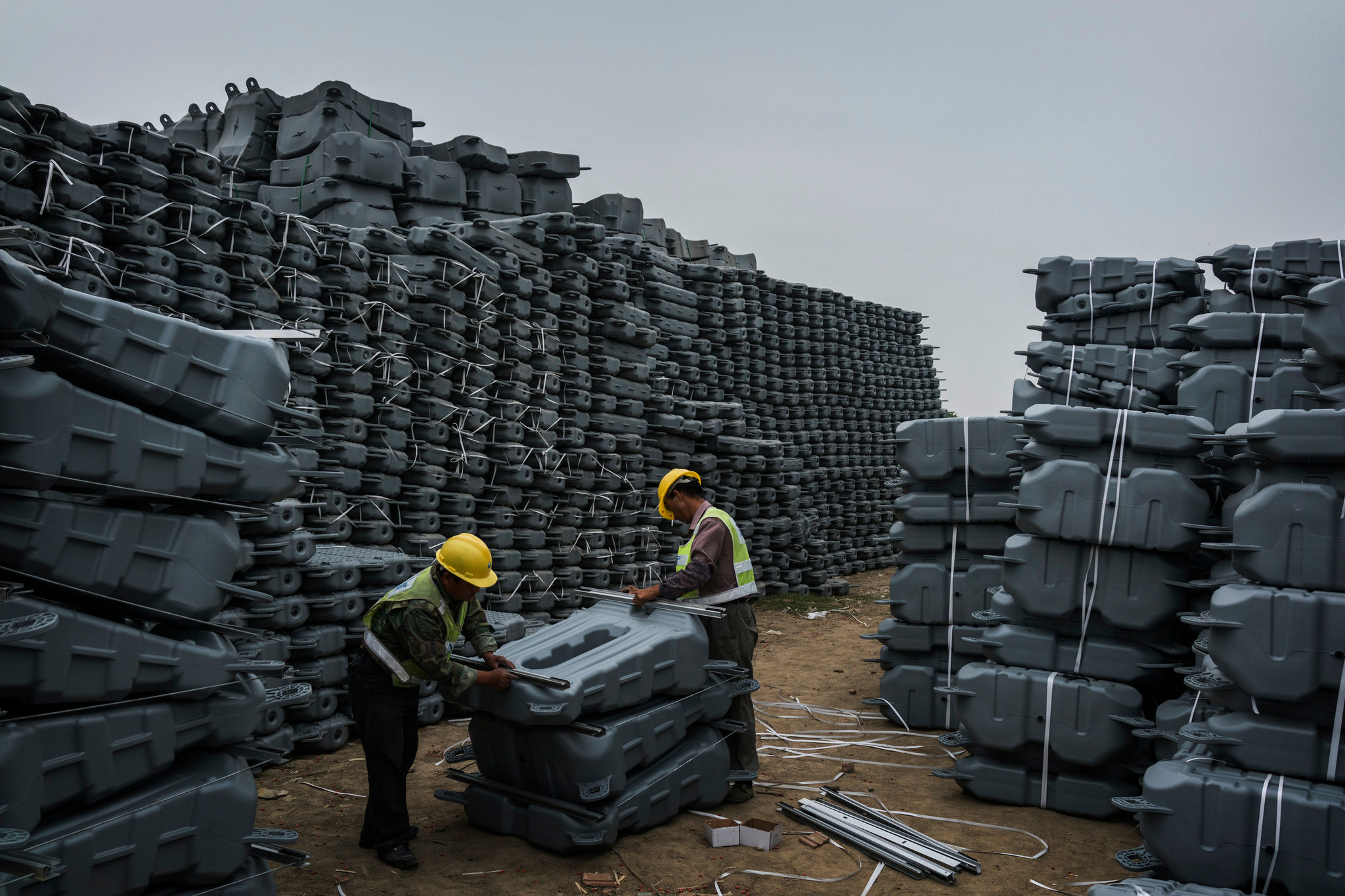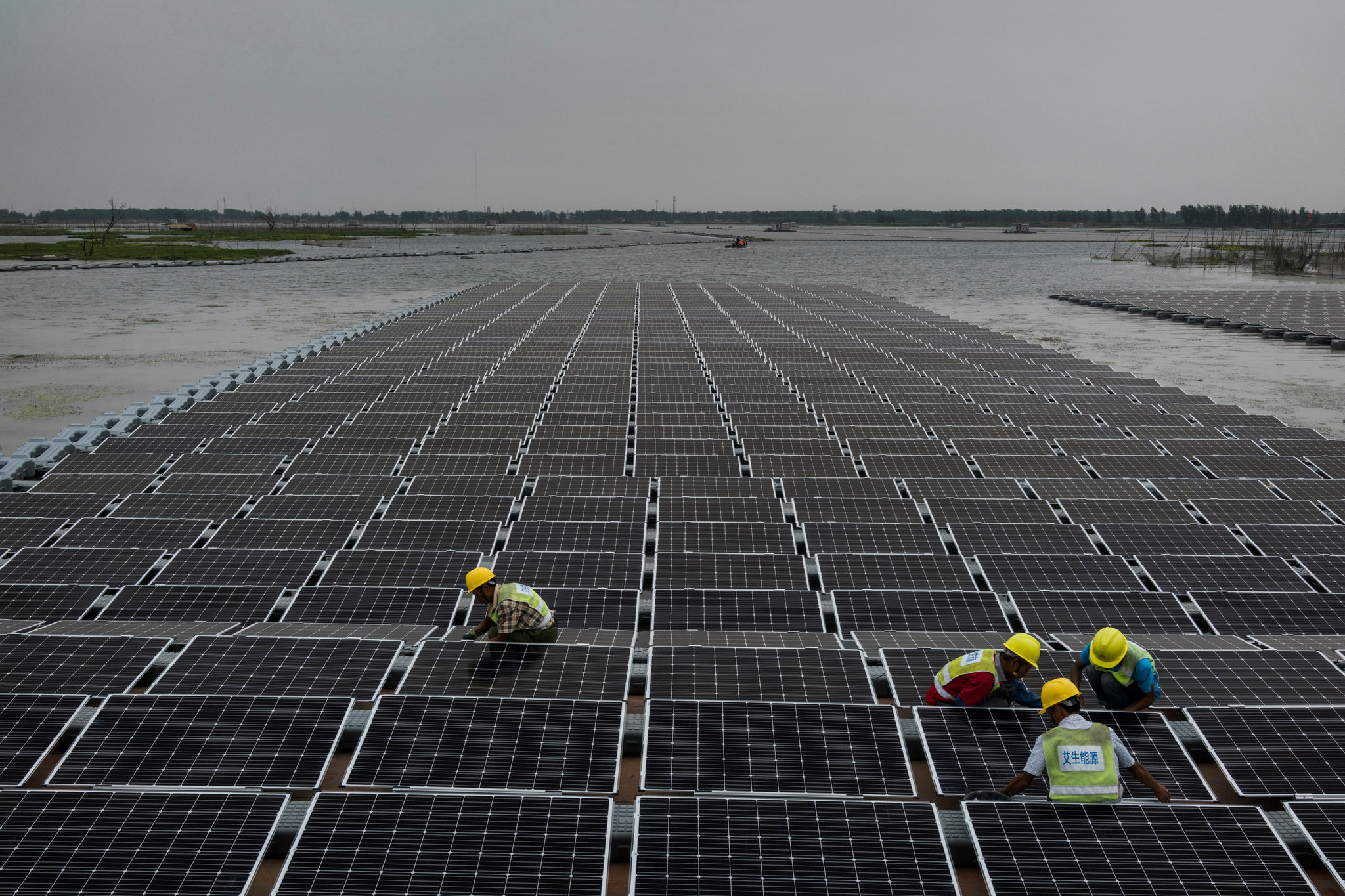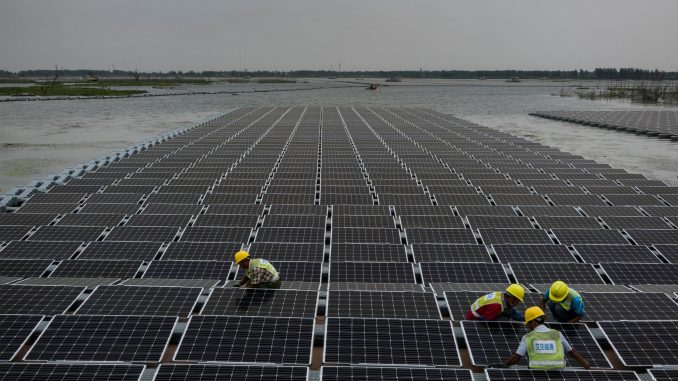
State-owned banks put tens of billions each year into solar & wind technologies, and energy conservation strategies like high-speed rail & subway lines. “One Belt, One Road” plan — a $1 trillion global offensive by President Xi Jinping to nurture economic and diplomatic ties through infrastructure building — is poised to bankroll clean-energy projects across Asia, including the Mideast; East Africa; and Eastern Europe. The projects give China an edge, pushing countries to buy from Chinese companies. China is already dominant in many low-carbon energy technologies. It produces two-thirds of the world’s solar panels and nearly half of the wind turbines. China is also rapidly expanding its fleet of nuclear reactors and leads the world by far in hydroelectric power. Top / Bottom: Workers from Sungrow wire together floating solar panels – on a lake created by the collapse of abandoned coal mines in Liulong, China. All Photos Credit Adam Dean for The New York Times.
China’s devastating pollution problems began in coal country,
where legions of workers toiled and often died to exhume the rich deposits that fueled the country’s sooty rise to economic power.
Today, those muddy plains are home to a potent symbol of China’s new ambition:
to bypass the United States and cement its dominant role in clean energy.
On a lake created by the collapse of abandoned coal mines,
China has built the world’s largest floating solar project,
enough to provide light and air conditioning to much of a nearby city.
The provincial government wants to expand the effort to more than a dozen sites,
which collectively would produce the same amount of power as a full-size commercial nuclear reactor.
Workers connecting waterproof solar panels to buoys on the shore of the lake.
Clean Energy Tech: Engine Of Domestic Growth & Global Partnerships
The project reflects China’s effort to reshape the world order in renewable energy as the US retreats.
Such technological expertise will form the infrastructure backbone needed for countries to meet their climate goals,
making China the energy partner of choice for many nations.
The wave-proof solar panels are an affordable and viable option for power-hungry countries.
Delegations from Japan, Taiwan, Vietnam, Singapore and elsewhere have come to study the project,
while the maker, Sungrow, prepares to license the technology for overseas sale.
China is capitalizing on the leadership vacuum left after Donald Trump said last week he would pull US out of the Paris accord to limit climate change.
China has already started an expensive campaign at home and abroad to solidify its considerable hold on solar, wind and other energy-saving businesses.
If successful, China would win the economic and diplomatic spoils the US and some European countries have long enjoyed from dominating businesses like
- software,
- computer chips and
- airplanes.
Beijing Global Summit On Clean Energy Tech
China’s sway is on display in Beijing this week at the Clean Energy Ministerial,
a gathering of top energy officials from two dozen countries and the European Union
that represent producers of three-quarters of the world’s greenhouse gas emissions.
While the US is there, its representatives reflect the country’s deep split:
Energy Secretary Rick Perry, an enthusiastic supporter of fossil fuel industries, will attend,
along with Gov Jerry Brown of California, a vocal supporter of renewable energy.
China Seizes Lead In On-Going Race To Dominate Renewable Energy
China is an unlikely champion in fighting climate change.
The country is the world’s largest polluter,
and its problems could grow as people buy more cars and use more power.
It remains deeply dependent on coal, an especially dirty source of power.
And the race in renewables hasn’t been won.
The US and EU accuse Beijing of unfairly subsidizing its green industries and have raised trade barriers against Chinese-made goods.
US companies and local governments are set to continue their clean-energy push despite Trump’s withdrawal from the Paris accord.
As with much in China, the clean-energy drive is as much about economic advantage, national security and political stability than an idealistic commitment to saving the earth.
Much like in every other major country in the world.
The country’s “Made in China 2025” program, the heart of Beijing’s domestic industrial policy,
calls for heavy spending on clean-energy research and development, as a way to bolster the economy.
State-owned banks are pouring tens of billions of dollars each year into technologies like solar and wind,
along with energy conservation strategies like high-speed rail and subway lines.
Workers at JA Solar in Hefei, China, making panels for Sungrow.
Machines that are used to produce the JA Solar panels.
“One Belt, One Road” Features Clean Energy Infrastructure Projects
China’s “One Belt, One Road” plan —
a $1 trillion global offensive by President Xi Jinping to nurture economic and diplomatic ties through infrastructure building —
is poised to bankroll clean-energy projects across Asia, including the Mideast; East Africa; and Eastern Europe.
The projects give China an edge, pushing countries to buy from Chinese companies.
China is already dominant in many low-carbon energy technologies.
It produces two-thirds of the world’s solar panels and nearly half of the wind turbines.
China is also rapidly expanding its fleet of nuclear reactors and leads the world by far in hydroelectric power.
“It’s different from traditional energy, which is dominated by Western countries,”
said Li Tao, the technical director at JA Solar, the Chinese supplier of Sungrow’s panels.
“China has an opportunity to surpass Western countries in new energy.”
Bad Pollution / Rising Oceans Pushed China To Develop Long-Term Strategy
Choking pollution problems and worries that rising ocean levels could devastate coastal cities
forced Beijing a decade ago to begin a campaign to find green solutions.
Local governments provided land for nearly free, and state-owned banks handed out enormous loans at very low interest rates.
Sometimes government agencies helped companies repay their loans.
Coal is getting far less attention.
While China is still building some coal-fired power plants, it has canceled plans for others.
Many existing ones are running well below capacity.
“Coal is over,” said Li Junfeng, a longtime renewable-energy official at the National Development and Reform Commission, China’s top economic planning agency.
“Every year, it will be gradually reduced, city by city.”
China’s green campaign is still in the early stages.
The solar industry employs more than one million workers in everything from making panels for export to installing them domestically,
though solar accounts for only 2% of its electricity needs.
By contrast, China has four million coal miners to supply the power plants that generate 70% of the country’s electricity.
Clean Energy Campaign Transforms Devastated Coal Country Into Solar Mecca
But the clean-energy effort is already transforming coal country.
For decades, Yang Xuancheng, a former coal miner in Liulong, here in Anhui Province in east-central China, toiled for 12-hour days in sweltering heat.
A natural gas explosion killed half his 20-member drilling team.
When mines emptied of coal began collapsing underground, the land subsided and his boyhood village disappeared into a 25-foot-deep hole.
The hole soon filled with rainwater and groundwater, creating a mile-wide lake.
Workers in Liulong making buoys that will be used to float solar panels.
Workers preparing the buoys. “This aboveground work is so much more pleasant than the hot air down in a coal mine,” a former miner said.
The lake is now the home of Sungrow’s floating solar power project.
Yang, 57, wires together the plastic tubes that carry the connective wiring for the panels.
“This aboveground work is so much more pleasant than the hot air down in a coal mine,” Yang said.
Such solar efforts have put China at the leading edge of renewables.
The US and Japan invented many of the key technologies for solar panels over the past half century.
But they were more cautious about building very large factories,
fearing they would have to cut prices below cost to sell all the panels.
Extremely cheap Chinese panels have driven dozens of Western companies out of business, including several more in recent months.
Chinese players like JinkoSolar and Trina Solar, the world’s biggest makers of solar panels, invested heavily in production.
Their highly automated plants churn out vast numbers of panels with consistent quality at ever-falling cost.
GCL Group, a large manufacturer in Suzhou, now relies on robots for much of its production,
from melting the raw materials for the silicon to assembling the final equipment.
The company has nearly doubled production in the past four years, even while cutting its work force nearly in half.
“If you don’t have the factories as a manufacturing base,
then new ideas and technical innovation will stay in the air and not amount to anything,”
said Lu Jinbiao, an executive vice president at GCL.
Chinese Gaining Sales In Fast-Growing Solar Markets Like India & Saudi Arabia
That technical know-how is helping Chinese companies capture sales in some of the world’s fastest-growing solar panel markets, like India and Saudi Arabia.
China is tailoring the technology for developing markets that will need innovative and cost-effective solutions to meet their climate goals.
JA Solar is redesigning some panels for very hot, dry deserts — and others for very humid jungles.
Doing so will make them cheaper to manufacture than a module created to withstand extreme heat and extreme humidity.
The panels at the lake in Liulong are made to be waterproof.
Xiao Fuqin, the chief engineer at Sungrow’s floating solar panel project, said
delegations arrive almost daily from around China and across Asia to examine the nitty-gritty specifications,
like how to lay large power cables underwater to connect many panels.
“This technology shows that China is keeping the leading role in solar, as it has for many years,” Xiao said.
“We have been the pioneers, and pushed our industry another small step forward.”
The wave-proof solar panels are affordable, and delegations from Japan, Taiwan, Vietnam and Singapore have come to study the project. All Photos Credit Adam Dean for The New York Times
V.O. Keith Bradsher
Source: China Looks to Capitalize on Clean Energy as U.S. Retreats – The New York Times
